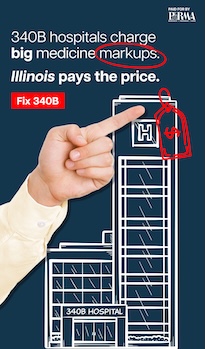* Background is here if you need it. From the House Democrats…
Leader Jeffries just got added to the Speaker’s Springfield schedule for this afternoon
The meeting with House Speaker Chris Welch to discuss congressional redistricting is at 4:30.
Checking with Senate President Harmon’s office. Stay tuned.
…Adding… Leader Jeffries will also meet today with Senate President Harmon.
* Meanwhile…
* Indiana Gov. Mike Braun calls a special session to redraw the state’s congressional boundaries: President Donald Trump has ramped up pressure on Republican governors to draw new maps that give the party an easier path to maintain control of the House in the midterms. While Republicans in Texas, Missouri and North Carolina have moved quickly to enact new districts and California Democrats are seeking to counter with their own redistricting plan, Indiana lawmakers have been far more hesitant. Braun called for the General Assembly to convene Nov. 3 for the special session. It’s unclear whether enough of the GOP majority Senate will back new maps.
…Adding… Common Cause has laid down some parameters for any redistricting move…
Illinois Redistricting Must Protect Fair Representation and Meet Common Cause Fairness Criteria
Chicago – Common Cause, the nation’s premier redistricting leader, is urging Illinois state legislators to ensure that any mid-decade redistricting meets the organization’s six fairness criteria. For weeks, rumors have swirled about the possibility of mid-decade redistricting to add an additional Democratic seat to the state’s congressional delegation during the veto period.
“For over 50 years, Common Cause has fought to make sure voters choose their politicians, not the other way around, and we’re not going to stop now,” said Elizabeth Grossman, Common Cause Illinois Executive Director. “Common Cause opposes mid-decade redistricting that does not meet our fairness criteria. Of particular concern is the prospect that new maps might dilute the political power of Black voters in Illinois—we cannot let this happen.”
“President Trump set off a cycle of mid-decade redistricting when he directed Texas to find him five more Republican seats,” said Dan Vicuña, Common Cause Senior Policy Director for Voting and Fair Representation. “Our fairness criteria were developed to meet this moment—to give every state engaging in mid-decade redistricting as counterbalance to President Trump’s partisan power grab a clear, consistent standard that prevents long-term harm to fair representation.”
Common Cause does not endorse partisan gerrymandering and created its Fairness Criteria as a national framework to guide states as they navigate this escalating redistricting cycle. The criteria were developed to prevent partisan reactions—Democratic and Republican alike—from entrenching long-term inequities in representation. To date, Common Cause has evaluated mid-decade redistricting in three states: California, Missouri, and Texas. States must meet all six criteria to avoid Common Cause’s opposition.
Common Cause’s Six Fairness Criteria:
• Proportionality: Any mid-decade redistricting should be a targeted response proportional to the threat posed by mid-decade gerrymanders in other states.
• Public participation: Any redistricting must include meaningful public participation, whether through ballot initiatives or open public processes.
• Racial equity: Redistricting must not further racial discrimination or dilute the political voice of Black, Latino, Indigenous, Asian American, and Pacific Islander, or other communities of color.
• Federal reform: A public endorsement of the John R. Lewis Voting Rights Advancement Act and the Freedom to Vote Act, including provisions banning mid-decade redistricting and partisan gerrymandering.
• Endorsement of independent redistricting: Leaders pursuing mid-decade redistricting must publicly endorse fair, neutral redistricting processes, such as, citizen-led independent redistricting commissions.
• Time-limited: Any new redistricting maps must expire following the 2030 Census.
To read more about Common Cause’s fairness criteria, click here.
To read Common Cause’s “50 State Report on Redistricting,” click here.














- Rahm's Parking Meter - Monday, Oct 27, 25 @ 12:53 pm:
Points to Rep. Davis for wearing an NIU hat at the press conference.
- OneOpinion - Monday, Oct 27, 25 @ 12:59 pm:
From the prior post, the Governor said: “But it doesn’t have to happen during veto session. It could happen after that, but right now there’s just a lot of conversation going on.” Hard to see this happening at all, but punting for veto session is an easy step.
- 44 - Monday, Oct 27, 25 @ 1:46 pm:
All of these states are so short sighted. Don’t you want a few people representing your state when the other party is in power? Red or blue state.
- jimbo - Monday, Oct 27, 25 @ 1:52 pm:
I know it won’t happen, but I’d sure like to see Darren Bailey’s reaction to a new district starting in SE Cook and running South anywhere from 10 to 30 miles wide from the Indiana border all the way down thru Olney.
- Norseman - Monday, Oct 27, 25 @ 1:53 pm:
Rahm’s Parking Meter @ 12:53 pm + 1.
- Inconvenient Observations - Monday, Oct 27, 25 @ 2:05 pm:
Wouldn’t redistricting now require that the petitions filed this week be tossed followed by a 2nd round of signature gathering?
60-30-Gov for that?
2nd observation - would a majority vote suffice or would 3/5ths be needed to change the maps for 2026?
- Norseman - Monday, Oct 27, 25 @ 2:11 pm:
Common Cause has their parameters, I have mine:
1) There must be a high degree of likelihood that Dems will pick up at least one seat; (I’m pessimistic)
2) National Dems need to commit extensive funding to support candidates in new districts and in districts made more vulnerable; and
3) If the above can be met, those sacrificing their jobs should be offered a parachute.
Our real Common Cause is to save the democracy from the authoritarian attack being led by Trump and his MAGA GOP sycophants.
- Just Another Anon - Monday, Oct 27, 25 @ 2:33 pm:
Don’t see the math mathing for the Black Caucus to support. If you are going to soak up all those rural white GOP votes, there’s not enough black votes on the south and west sides to go around. You very well be able to get to 16-1. You very well may be able to draw all R incumbents into one district as well. But to do either of those things, you run into some cold hard facts. The first issue is that the black population represents about 14% of Illinoisans (1.7 Million). The second issue is one of geography. The South and West Sides of Chicago and East St. Louis are the lodestones for a large majority of the black population. Hard to not crack that up. The third issue is the existing breakdown. Currently White -10; Black -4; Hispanic -2, Other -1. Black Caucus is currently over represented (14% of the population representing about 24% of the congressional seats). Hispanics make up about 18% and only get about 12% of the congressional districts. The fourth issue is the fact that the map is already fully leveraged to preserve both the 5 majority minority districts (1,2,3,4,7). There is no “easy” way to maintain the black caucuses priority (4 seats vs 2 for the larger hispanic population; max map requires 2 hispanic majority, 1 black majority); keep the seats non-competitive for democrats (11 of the seats would have a 5% or less advantage; currently 6 seats have a 5% or less advantage), and not displace a number of incumbent Dems; and be even minimally compact (a figleaf to the constitutional requirement). If I’m the local black caucus, I’m saying, what is in it for me. I’m giving up my districts and working a lot harder to shore up 2 votes for you (maybe) in DC. I don’t know that the votes are there without the black members.
- JS Mill - Monday, Oct 27, 25 @ 2:59 pm:
=Black Caucus is currently over represented (14% of the population representing about 24% of the congressional seats). Hispanics make up about 18% and only get about 12% of the congressional districts. =
I don’t think the black caucus wants to hear the truth but demographics are not on their side. It is only a matter of time before the Latino caucus claims more seats.
- System Reboot - Monday, Oct 27, 25 @ 4:11 pm:
I think a lot of politicians outside Illinois struggle to understand the inner-dynamics of our state and especially how race influences Illinois politics. So many factors influence our state, particularly the outsized dominance of Chicago compared to the rest of the state, how Chicago’s segregation can yield tribalism, and how such segregation exacerbates racial bias across our politicians (regardless of race). Not only that, Illinois voters / politicians are VERY skeptical of outsiders to our state, and Leader Jeffries is no exception. If Jeffries WANTS to become a real national leader in the party, and unify the Democrats behind him, he’s gonna be in for a rude awakening about how Illinois works…